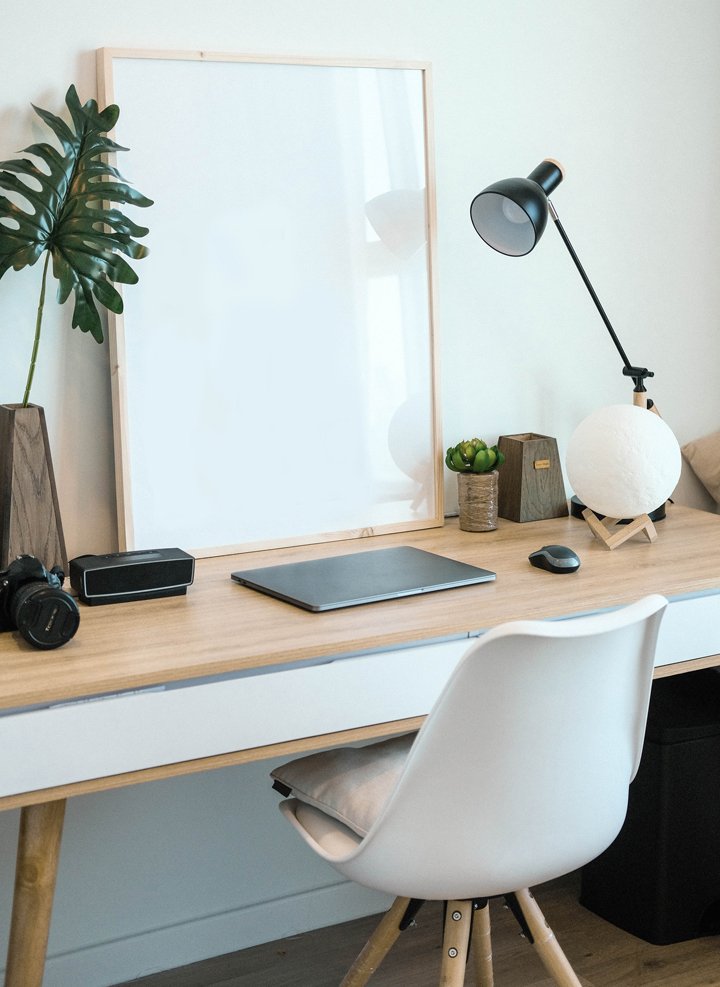Did you know that your desk height and setup will affect your comfort (and as a result, your productivity) at work? But the average desk height won’t suit everyone, as we’re all built differently.
In this article, I’ll share what the standard computer desk height is. But I’ll also give you some tips on setting up your desk to ensure an ergonomic sitting position.
If you don’t have the proper desk height for your needs, you could end up with back, neck, and shoulder pain. According to this study, having the correct desk height can reduce lower back pain.
And as a result, you’ll be able to focus better and work to your best ability. Not to mention that improving your comfort will lead to better overall wellbeing.
While there is an average desk height, that doesn’t mean that it’s suitable for you. Many desks are adjustable anywhere between 24 to 36 inches tall. But working out the correct standard height for your body is essential. You’ll need to adjust your desk to your own needs – especially if you’re taller or shorter than average.
So let’s take a look at how to set up the best ergonomic desk height.
What is the standard computer desk height?

If you’re wondering what the standard desk height is, it tends to be anywhere from 28 to 30 inches. That’s the most common height you’ll find in workplaces around the country and the world.
But it’s important to note that this standard desk height won’t suit everyone. It’s best suited to taller individuals, but anyone below average will need to adjust it.
It’s not comfortable to sit at a typical desk height but you have to raise your arms to type. Or you may have sat at a desk where your feet didn’t firmly reach the floor. Having dangling legs isn’t a nice experience, nor does it encourage your productivity.
So, don’t forget to take the ‘normal’ desk height with a pinch of salt. Instead, you can follow my tips below to ensure you have the best setup for your needs.
What is the best ergonomic desk height?

The truth is that there isn’t one best ergonomic height for everyone. People differ in height but also in their body proportions. For example, some people have longer torsos, legs, or even a longer neck.
But the best ergonomic height will ensure proper posture and comfort. As a result, you’ll protect your health for the long term. If your desk isn’t at the right height, you might not notice anything at first. But you could develop aches and pains over time.
So, how can you work out what the proper height for your desk is? For most people, it will fall somewhere between 23 to 32 inches high. I’ll explain how you can set your desk up at the correct height below.
How high should my desk be?

Now you know the best ergonomic height for a desk. But what does that mean for yourself?
Of course, you want to get the perfect height for your desk, but it’s a little complicated. There isn’t a one-size-fits-all desk setup that will work for everyone.
As mentioned above, it can vary from person to person. The exact height will depend on your height, as well as your torso, leg, and neck length. Unfortunately, there’s no one simple answer to this question.
But there are ways to work out if your desk is at the right height. For example, you’ll know your desk is at the correct height if you can sit comfortably in it. The key factor is that the desk should be at your elbow level so you can rest your arms easily on the surface. And your feet should rest firmly on the floor without having to stretch.
How high should a standing desk be?

Standing desks are an excellent option as they allow you to shift your position. Sitting in a status position for too long has been shown to increase the risk of back pain. And the more you can move about, the better it is for your health, posture, and even your productivity.
But how can you know if your standing desk is at the proper desk height? Again, it will depend on your own height and proportions, so it’s a very individual decision. There’s no one clear height that will work for everyone.
The best way to ensure your standing desk is set up correctly is that the desk surface is at your elbow level. Then, you’ll have an ergonomic position for typing. Plus, you’ll avoid putting extra strain on your wrists, shoulders, and back.
More tips for an Ergonomic Sitting Position at Work:

So, your desk is set up comfortably at the correct height. That’s a great start, but there are a few more things you can do to ensure you have an ergonomic sitting position:
- When changing desks, make sure to adjust your new desk for a couple of minutes. You’ll find it easier to concentrate in a comfortable, ergonomic sitting position.
- Aim to sit upright at your desk and relax your shoulders down.
- I would also recommend taking short breaks to get up and walkabout. You could also add a short desk yoga routine to stretch, relax, and refocus. That will help boost your concentration and support your overall health.
- Make sure you have plenty of room beneath the desk for your legs. Then, you will find it easier to move your legs and keep your blood flowing throughout the workday.
- A shiny desk can amplify glare from screens and lights, which can be harsh on your eyes. Opt for a desk with a matte finish to avoid this happening.
- You can invest in a monitor arm to hold your monitor at the optimal height. When working on a computer, you should look straight ahead at the screen rather than looking down. That will reduce the strain on your neck, back, and shoulders and prevent forward neck posture.
- Choose a comfortable, adjustable desk chair with plenty of support. Don’t forget to set it at the right height for you, too.
- You might also find a keyboard tray helpful as it frees up space on your desktop. It also ensures that you can type in a comfortable, ergonomic position.
- An ergonomic mouse or mouse pad can also make a huge difference to your comfort. There are options for left-handed users, too.
Average Desk Height FAQ
Are 32 inches too high for a desk?
Whether 32 inches is too high for a desk depends on your own height. It should be fine if you’re taller than 5’10, as you’ll need a higher desk. But 32 inches is too high for shorter people to sit comfortably in an ergonomic position.
What is the ergonomically correct height for a desk?
The ergonomic average height for a desk is anywhere between 23 to 32 inches high. It depends on the user, but most people need a desk height between 25 and 30 inches.
What can I do if my desk is too high?
If you’ve discovered that your desk is too high, but it’s not adjustable, there are some things you can do. Firstly, try to raise the height of your desk chair so the surface is at your elbow height. Then, you may need a footrest to place your feet comfortably. You may need to adjust your monitor height, too.

The Wrap Up
Your desk setup has a huge impact on your comfort, wellbeing, and even your productivity at work. So, it’s important to find out the best ergonomic height for your desk. For many people, the average desk height isn’t the optimal height, so you may need to make adjustments.
But with this guide, you should be able to create a comfortable, ergonomic workstation. Let me know if you have any questions in the comments (or share your own tips)!
Make sure to follow me on Pinterest for more tips, reviews, and resources.





